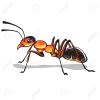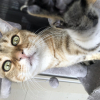- Formiculture.com
- Forums
- Gallery
- Members
- Member Map
- Chat

Feeding time
Started By
Diesel
, Dec 4 2016 11:56 AM
9 replies to this topic
#1
 Offline
-
Posted December 4 2016 - 11:56 AM
Offline
-
Posted December 4 2016 - 11:56 AM
Well I've found changing my ants diet every couple days seems to work best for my ants. I guess my question is how often should I feed my ants a protein source and how often a sugar? They stop eating sugars I throw a,protein in.suitable?
Ant Species kept
Temnothorax Longispinosus.-Journal(discontinued)-(formerly)
Camponotus Noveboracensis (formerly)
Camponotus Nearticus-formerly
Tetramorium sp.-formerly
Camponotus Pennsylvanicus Queen & brood.-formerly
Tapinoma Sessile-Journal (3 queen colony)-formerly
Tapinoma Sessile #2 (2 queen colony)-formerly
Aphaenogaster Picea-Journal-active
Crematogaster sp.(Cerasi or Lineolata) Queen with 3 workers and brood-formerly
Crematogaster sp. #2 (Cerasi or Lineolata) Queen with brood-formerly
Formica sp. polygenus-active 300+ workers-active
Formica Subsericea-active 25+ workers-active
Myrmica Rubra 400+ workers 3 queens-active
#2
 Offline
-
Posted December 4 2016 - 12:03 PM
Offline
-
Posted December 4 2016 - 12:03 PM
I do 2 insects a week and always leave in an sugar water liquid feeder but also leave a honey drop or some sweet on the dish as well.
#3
 Offline
-
Posted December 4 2016 - 1:43 PM
Offline
-
Posted December 4 2016 - 1:43 PM
Thanks for the tip
Ant Species kept
Temnothorax Longispinosus.-Journal(discontinued)-(formerly)
Camponotus Noveboracensis (formerly)
Camponotus Nearticus-formerly
Tetramorium sp.-formerly
Camponotus Pennsylvanicus Queen & brood.-formerly
Tapinoma Sessile-Journal (3 queen colony)-formerly
Tapinoma Sessile #2 (2 queen colony)-formerly
Aphaenogaster Picea-Journal-active
Crematogaster sp.(Cerasi or Lineolata) Queen with 3 workers and brood-formerly
Crematogaster sp. #2 (Cerasi or Lineolata) Queen with brood-formerly
Formica sp. polygenus-active 300+ workers-active
Formica Subsericea-active 25+ workers-active
Myrmica Rubra 400+ workers 3 queens-active
#4
 Offline
-
Posted December 4 2016 - 2:06 PM
Offline
-
Posted December 4 2016 - 2:06 PM
A colony will need access to both protein and sugar in order to stay healthy. Mixing up the diet would mean providing new versions of the same thing, like swapping feeder insects or giving them a slice of ripe banana instead of honey. Ants also have vitamin needs, very much like our own, so variety is going to be important to the health of the colony.
Edited by Batspiderfish, December 4 2016 - 2:07 PM.
- dermy likes this
If you've enjoyed using my expertise and identifications, please do not create undue ecological risk by releasing your ants. The environment which we keep our pet insects is alien and oftentimes unsanitary, so ensure that wild populations stay safe by giving your ants the best care you can manage for the rest of their lives, as we must do with any other pet.
Exotic ants are for those who think that vibrant diversity is something you need to pay money to see. It is illegal to transport live ants across state lines.
----
Black lives still matter.
#5
 Offline
-
Posted December 4 2016 - 3:54 PM
Offline
-
Posted December 4 2016 - 3:54 PM
I found that if I let them starving for a while, the foods will get taken faster. Otherwise they usually left the food behind.
#6
 Offline
-
Posted December 4 2016 - 4:12 PM
Offline
-
Posted December 4 2016 - 4:12 PM
If you find you are needing to rotate your diet too often, or that ants aren't eating foods they've eaten before, there can be but a few causes:
- Ants have collected as much food as is needed at the present time
- Colony is nearing hibernation or is in poor health
- The ants are searching for nutrients not contained in the foods offered, or other environmental cause
Improper Feeding Frequency & Amounts:
If you're simply feeding too often, you may observe increased foraging activity by reducing the frequency and/or amounts of food being offered—either will increase receptivity.
Feeding amount and frequency is a special consideration for small colonies. Think of a small colony the same as you would a baby bird. Small colonies, and those with few larvae, will require the least amount of food, but are more likely to require a higher frequency of feeding, as the community social stomach is very small. Feed smaller portions, but more often. Keep in mind that larvae consume the most protein. Workers consume very little protein, as they can only ingest liquids, and eggs and pupae consume nothing.
Hibernation and Adverse Health:
If the colony is nearing hibernation or is in poor health, the colony will mostly only collect sweets, as brood production slows to a halt. Ensure the colony has ad libitum access to fresh water and a sugary liquid, such as Sunburst Ant Nectar. Captive colonies, and those found away from coastal areas, are frequently deficient in salts like sodium and potassium, both of which are present in Sunburst Ant Nectar, and will improve feeding response.
Nutrient Deficiency or Environmental:
If your colony is ignoring foods offered previously, and you're also observing all of the following from the list below, then you may be experiencing a nutrient deficiency, symptoms of dehydration, or are keeping the colony or foraging area at a sub-optimal temperature:
- Has gone several days without feeding
- Has lots of hungry larvae
- Is actively foraging, OR is huddled closely together in the nest, but not due to diapause
If the cause is related to diet, offering Sunburst Ant Nectar may help because it contains an optimal blend of sugar, water, and electrolytes to ensure colony health. Colonies fed Sunburst as the exclusive sugar source should be more receptive to insects and other natural foods, without the need for rotation. Sunburst also helps with dehydration, since it has a high percentage of water when compared to honey, which could actually promote dehydration. Continue to provide fresh, non-chlorinated water so the ants may collect the perfect balance.
If changes to diet do not yield satisfactory results, consider the temperature at which the colony is being kept. Low temperatures may reduce or completely halt foraging activity. A heating cable may be used to apply targeted heat to specific areas of the nest, and it will be easy to judge the ants' reaction to the placement. If the ants move closer to the heating cable, you will know the temperature is too low—if they move away from it, then the temperature in that area is too high.
Edited by drtrmiller, March 4 2019 - 9:01 PM.
- Reacker, FSTP and AntsBrazil like this
byFormica® is the manufacturer of the iconic nectar feeders and Sunburst Ant Nectar.
byFormica ant products always deliver consistent performance, convenience,
and reliability, making them among the most beloved ant foods and kit enjoyed by
ant keeping enthusiasts worldwide. For more information, visit www.byFormica.com.
#7
 Offline
-
Posted December 4 2016 - 4:24 PM
Offline
-
Posted December 4 2016 - 4:24 PM
The protein seems to be the food I'm changing. The sugar water has been consumed on a regular basis. They loved the first meal worm but not so much the second. The crickets they love so far. I just want to make sure that they are getting what they need. I'll have to look at the sunburst nectar as an alternative sugar source. The larvae are growing quickly and the workers are actively seeking food. The outworld isn't hooked up yet as I am waiting for the next batch of workers to arrive.
Ant Species kept
Temnothorax Longispinosus.-Journal(discontinued)-(formerly)
Camponotus Noveboracensis (formerly)
Camponotus Nearticus-formerly
Tetramorium sp.-formerly
Camponotus Pennsylvanicus Queen & brood.-formerly
Tapinoma Sessile-Journal (3 queen colony)-formerly
Tapinoma Sessile #2 (2 queen colony)-formerly
Aphaenogaster Picea-Journal-active
Crematogaster sp.(Cerasi or Lineolata) Queen with 3 workers and brood-formerly
Crematogaster sp. #2 (Cerasi or Lineolata) Queen with brood-formerly
Formica sp. polygenus-active 300+ workers-active
Formica Subsericea-active 25+ workers-active
Myrmica Rubra 400+ workers 3 queens-active
#8
 Offline
-
Posted December 4 2016 - 4:30 PM
Offline
-
Posted December 4 2016 - 4:30 PM
They seem to be healthy and doing well as is the queen. They have moved the brood to the heater cable although one egg was lost in the tiny gap. They have been unable to reach it. I've tried to assist but to no avail. they keep checking that gap as they know that its there but was crushed by their constant attempt at retrieving it
they keep checking that gap as they know that its there but was crushed by their constant attempt at retrieving it
- antgenius123 likes this
Ant Species kept
Temnothorax Longispinosus.-Journal(discontinued)-(formerly)
Camponotus Noveboracensis (formerly)
Camponotus Nearticus-formerly
Tetramorium sp.-formerly
Camponotus Pennsylvanicus Queen & brood.-formerly
Tapinoma Sessile-Journal (3 queen colony)-formerly
Tapinoma Sessile #2 (2 queen colony)-formerly
Aphaenogaster Picea-Journal-active
Crematogaster sp.(Cerasi or Lineolata) Queen with 3 workers and brood-formerly
Crematogaster sp. #2 (Cerasi or Lineolata) Queen with brood-formerly
Formica sp. polygenus-active 300+ workers-active
Formica Subsericea-active 25+ workers-active
Myrmica Rubra 400+ workers 3 queens-active
#9
 Offline
-
Posted January 3 2017 - 11:28 PM
Offline
-
Posted January 3 2017 - 11:28 PM
Sometimes combining food helps.(Kind of like baby food) You can do a mix like putting honey on the insects you feed them to make the food more attractive.
Currently own:
(1x) Camponotus Sp.
(1x) Pheidole aurivillii (?)
(1x) Monomorium Sp. (?)
Other
#10
 Offline
-
Posted January 4 2017 - 6:42 AM
Offline
-
Posted January 4 2017 - 6:42 AM
Sometimes combining food helps.(Kind of like baby food) You can do a mix like putting honey on the insects you feed them to make the food more attractive.
In this case, the ants would be attracted to the honey, not what's beneath the honey. One can mix poison with sugary sweets, as well, and the ants will devour it.
Ants sense the world primarily by smell, and so coating a food which the ants are not consuming with another food, such as honey, which the ants do consume, is not going to help the antkeeper determine the foods to which the ants are attracted.
A prime example of this effect was the Blue 100 diet, which was composed of sugar, egg, and milk proteins. If you separate the ingredients out, the main attractant was the sugar, and to a lesser extent the egg. I never observed ants consume the whey/casein protein on its own, and so I understand now that this food source was suboptimal. That is why I am testing each food component of my ant diets individually, going forward, because if the ants are attracted to all of them, then they'll be attracted to the combination of them, as well.
byFormica® is the manufacturer of the iconic nectar feeders and Sunburst Ant Nectar.
byFormica ant products always deliver consistent performance, convenience,
and reliability, making them among the most beloved ant foods and kit enjoyed by
ant keeping enthusiasts worldwide. For more information, visit www.byFormica.com.
0 user(s) are reading this topic
0 members, 0 guests, 0 anonymous users

















